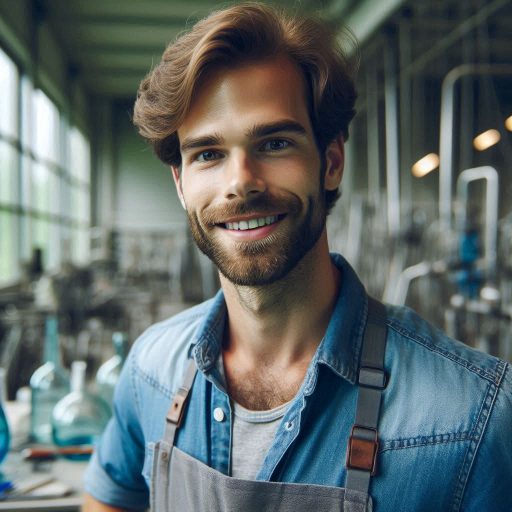Introduction
Glass art is a captivating form of artistic expression that involves shaping molten glass into stunning pieces.
Using various techniques like blowing, casting, and fusing, artists create intricate and delicate glass sculptures and installations.
Glass art has the power to evoke emotions, spark creativity, and inspire awe in those who witness it.
Transition into discussing inspirational glass art design ideas
Here are some inspirational glass art design ideas that showcase the beauty and versatility of this unique medium:
- Stained glass windows: Create colorful and intricate designs that play with light and shadows in architectural spaces.
- Sculptural glass vessels: Craft delicate and unique vases or bowls that showcase the fluidity and transparency of glass.
- Glass mosaics: Combine fragments of colored glass to form intricate patterns and images that tell a story.
- Fused glass jewelry: Design elegant and wearable art pieces by fusing different layers of glass together.
- Blown glass sculptures: Shape molten glass into intricate sculptures that capture movement and fluidity in a solid form.
Each of these design ideas offers endless possibilities for artists to explore their creativity and push the boundaries of glass art.
Abstract shapes
Glass art has been used for centuries to create stunning and inspirational designs.
One of the key elements in glass art is the use of abstract shapes.
Abstract shapes can evoke strong emotions and create a unique visual impact in glass art pieces.
How abstract shapes in glass art can evoke emotions
Abstract shapes in glass art are geometric forms that do not directly represent objects or figures in the real world.
These shapes can be fluid and organic, or sharp and angular, adding visual interest and complexity to the artwork.
Abstract shapes in glass art have the power to evoke emotions in viewers.
Bold, dynamic shapes generate energy and excitement.
Softer, subtle shapes evoke calmness and tranquility. Use shapes to create movement and contemplation.
Famous Glass Artists Known for Abstract Designs
- Dale Chihuly: Renowned for his elaborate and vibrant glass installations featuring abstract shapes.
- Lino Tagliapietra: Known for his mastery of Murano glassblowing techniques, creating intricate and complex abstract forms.
- Marta Klonowska:Uses shattered shards of glass to construct animal sculptures with abstract shapes.
- Klaus Moje: Pioneered the use of kiln-formed glass as an art medium, incorporating abstract geometric patterns in his work.
Tips for Incorporating Abstract Shapes
- Experiment with different shapes: Play around with geometric forms like circles, squares, triangles, and free-flowing organic shapes to create visual interest.
- Use contrasting colors: Incorporate bold, contrasting colors to make the abstract shapes pop and add depth to the artwork.
- Focus on composition: Pay attention to the balance and arrangement of abstract shapes within the piece to create a harmonious and visually appealing design.
- Play with transparency: Utilize the unique qualities of glass by playing with transparency and light to enhance the impact of abstract shapes.
In essence, abstract shapes play a crucial role in creating inspirational glass art designs.
By experimenting with different shapes, colors, and compositions, artists can evoke strong emotions and create visually stunning pieces that captivate viewers.
Embracing the power of abstract shapes in glass art opens up endless possibilities for creativity and expression.
Read: Glass Art vs. Traditional Art Forms
Colorful Glass Mosaics
When it comes to creating inspirational glass art design ideas, one cannot overlook the beauty and versatility of colorful glass mosaics.
One of the most striking features of glass mosaics is the vibrant colors they bring to a space.
Whether used as an accent or a focal point, these colorful pieces can instantly brighten up any room.
Transform Your Career Today
Unlock a personalized career strategy that drives real results. Get tailored advice and a roadmap designed just for you.
Start NowUsing a variety of hues in your glass mosaics can create a dynamic and visually appealing look.
Mixing different shades and tones can add depth and interest to your design, making it truly unique.
How Vibrant Colors Can Brighten a Space
Color has a powerful impact on our emotions and can influence how we feel in a space.
Bright, vibrant colors like those found in glass mosaics can evoke feelings of joy, energy, and creativity.
By incorporating colorful glass mosaics into your design, you can transform a dull or ordinary space into a lively and inspiring environment.
These pieces can serve as a source of inspiration and motivation for both you and your guests.
Benefits of Using Glass Mosaics in Design
There are several benefits to using glass mosaics in your design projects:
- Easy to clean and maintain
- Reflect light and create a sense of space
- Durable and long-lasting
- Can be used in various applications, from backsplashes to accents
These benefits make glass mosaics a practical and stylish choice for adding color and interest to your space.
Creating Colorful Glass Mosaics at Home
If you’re feeling inspired to create your own colorful glass mosaics at home, here are a few tips to get you started:
- Start with a clear design or pattern in mind
- Choose a color palette that complements your existing decor
- Invest in quality glass tiles for a polished finish
- Consider using a tile adhesive specifically designed for glass
- Don’t be afraid to experiment with different layouts and patterns
- Seal your finished mosaic to protect it from wear and tear
Creating your own colorful glass mosaics can be a fun and rewarding project that allows you to express your creativity and style in a unique way.
In fact, the use of colorful glass mosaics in design can have a powerful impact on the look and feel of a space.
By incorporating these vibrant pieces into your projects, you can create a visually stunning environment that is both inspiring and uplifting.
Read: Exploring Modern Glass Art Trends
Nature-inspired designs
When it comes to glass art design ideas, nature-inspired designs are a popular choice for many artists.
These designs often incorporate elements from the natural world, bringing the beauty of the outdoors inside and creating a sense of calm and serenity in any space.
Nature-inspired glass art can range from intricate floral patterns to bold representations of landscapes and wildlife.
These designs can be abstract or more realistic, depending on the artist’s style and inspiration.
Bringing the Outdoors Inside
One of the key benefits of using nature-inspired designs in glass art is that they can help bring the outdoors inside, creating a connection to nature in any space.
This can be especially beneficial in urban environments where access to green spaces may be limited.
Showcase Your Business Today
Reach thousands of readers actively exploring professional services. Publish your business profile and grow your audience now.
Publish NowCommon Nature Motifs
- Flowers: Roses, lilies, and daisies are commonly used motifs in nature-inspired glass art.
- Leaves: Oak leaves, maple leaves, and other foliage are often incorporated into designs.
- Animals: Birds, butterflies, and other wildlife can add a whimsical touch to glass art pieces.
- Landscapes: Mountains, forests, and seascapes are popular themes for nature-inspired glass art.
Tips for Incorporating Natural Elements
When incorporating natural elements into glass art projects, it’s important to consider the overall theme and aesthetic of the piece.
Here are some tips to help you successfully incorporate natural elements into your glass art:
- Choose a color palette that reflects the natural world, such as greens, blues, and earth tones.
- Experiment with different textures and finishes to mimic the look and feel of natural materials like wood or stone.
- Use organic shapes and flowing lines to create a sense of movement and fluidity in your design.
- Consider incorporating elements like twigs, leaves, or flowers into your glass art for added dimension and interest.
By following these tips and exploring nature-inspired designs, you can create stunning glass art pieces that bring the beauty of the outdoors into your home or workspace.
Read: How to Market Your Mural Art Business Effectively

Stained Glass Windows
Stained glass windows have been a significant form of art and decoration for centuries.
They are not only beautiful but also have religious and historical significance.
Stained glass windows were first used in churches and cathedrals as a way to educate the illiterate population about religious stories and figures.
The colors and designs in stained glass windows were carefully chosen to convey specific messages and evoke emotions.
Today, stained glass windows are still prevalent in religious buildings but also in homes, museums, and public spaces as a form of art and decoration.
Historical Significance of Stained Glass Windows
Stained glass windows date back to ancient times, with examples found in Roman and Byzantine architecture.
However, it was during the Gothic period in the 12th century that stained glass windows became more prevalent and elaborate.
In medieval Europe, stained glass windows were often used to tell biblical stories and showcase the wealth and power of the Church.
Each piece of colored glass was handmade and painstakingly fitted together to create intricate designs.
The vibrant colors and play of light through stained glass windows were meant to inspire awe and reverence.
Ideas for Modern Interpretations of Stained Glass Designs
While traditional stained glass windows are still popular, modern interpretations of this art form have taken on new styles and techniques.
Contemporary artists are experimenting with different types of glass, textures, and shapes to create unique and innovative designs.
Some artists use recycled glass or incorporate new technologies like LED lighting to add a modern twist to stained glass windows.
Others draw inspiration from nature, abstract art, or geometric patterns to create visually stunning pieces that evoke emotion and creativity.
The possibilities for modern stained glass designs are endless, limited only by the artist’s imagination.
Resources for Learning How to Create Stained Glass Windows
If you are interested in learning how to create stained glass windows, there are many resources available to help you get started.
Local community colleges and art centers often offer classes in stained glass techniques, from basic to advanced levels.
Online tutorials and instructional videos can also be found on websites like YouTube and craft-focused platforms.
Books and magazines dedicated to stained glass art provide valuable information on tools, materials, and techniques.
Additionally, joining a local stained glass club or community group can connect you with experienced artists who can offer guidance and support as you develop your skills.
With patience, practice, and passion, you can create beautiful stained glass windows that inspire and delight viewers for generations to come.
Read: Essential Tools for Glass Artists
Delve into the Subject: How to Present Your Industrial Design Work Effectively
Sculptural Glass Pieces
Glass art has long been admired for its beauty and delicacy, but sculptural glass pieces take this art form to a whole new level.
These pieces are not only visually stunning but also incredibly intricate and impressive in their design.
One of the most fascinating aspects of sculptural glass pieces is the way light interacts with the material.
Glass has a unique ability to reflect and refract light, creating a mesmerizing display of colors and patterns.
When sculpted into intricate forms, glass can become a work of art that seems to come alive in the light.
Sculptural Qualities of Glass Art
Sculptural glass art is a unique form of artistic expression that combines the fragility of the material with the strength and durability required to create intricate designs.
Artists who work with glass must possess a deep understanding of the material and its properties in order to manipulate it into the desired shapes.
Glass art showcases sculptural qualities beautifully.
Artists explore various themes and concepts. They capture nature’s ethereal beauty.
They also highlight bold, dynamic modern shapes.
Whether creating abstract sculptures or realistic depictions of everyday objects, glass artists have a wealth of possibilities at their fingertips.
Profiles of Sculptors Known for Their Glass Art Creations
One of the most famous glass artists known for their sculptural creations is Dale Chihuly.
His work is characterized by its bold colors and intricate patterns, as well as its large-scale installations that showcase the versatility of glass as an artistic medium.
Showcase Your Business Today
Reach thousands of readers actively exploring professional services. Publish your business profile and grow your audience now.
Publish NowAnother notable sculptor in the world of glass art is Lino Tagliapietra, whose work combines traditional Italian glass blowing techniques with modern design concepts.
His pieces are known for their elegance and sophistication, as well as their intricate details and precise craftsmanship.
Techniques for Sculpting Glass into Unique Forms
There are several techniques that artists use to sculpt glass into unique forms.
One of the most common methods is glass blowing, where artists heat the glass to a molten state and then shape it using various tools and molds.
This allows for a great degree of control over the final form of the piece.
Another technique for sculpting glass is called kiln forming, where artists use a kiln to heat glass and then shape it into molds or patterns.
This method allows for precise control over the final shape and texture of the glass, resulting in pieces that are both beautiful and durable.
In addition to these traditional methods, artists also use cutting and engraving techniques to sculpt glass into unique forms.
By carefully cutting and shaping the glass, artists can create intricate patterns and designs that add depth and complexity to their pieces.
Overall, sculptural glass art is a vibrant and dynamic art form that continues to inspire and captivate viewers around the world.
With its unique qualities and limitless possibilities, sculptural glass pieces are a testament to the creativity and skill of the artists who work with this versatile material.
Functional glass art
How glass art can also be practical
Functional glass art pieces serve both aesthetic and practical purposes, adding beauty and functionality to any space.
These unique creations can elevate the style of a room while also serving a useful function.
Glass art can also be practical through the use of functional items like vases, bowls, lighting fixtures, and even furniture.
These pieces blend artistic expression with utility, making them a versatile addition to any home or office.
Examples of functional glass art pieces
Examples of functional glass art pieces include hand-blown glass vases that can hold flowers or decorative stems, providing a pop of color and elegance to a room.
Glass bowls can be used for serving food or as decorative centerpieces on tables.
Functional lighting fixtures made of glass, such as pendant lights or chandeliers, can enhance the ambiance of a space while providing much-needed illumination.
These pieces can be customized to match any decor style, from modern to traditional.
Glass furniture pieces like tables, shelves, or countertops can add a contemporary touch to a room’s design while offering a durable and easy-to-clean surface.
These furniture items create a sleek and sophisticated look while also being practical for daily use.
Suggestions for incorporating functional glass art into everyday life
Suggestions for incorporating functional glass art into everyday life include using glass vases to display fresh flowers or greenery to bring nature indoors.
Glass bowls can be used as fruit bowls or for serving snacks during gatherings with friends and family.
Glass lighting fixtures can be installed in various rooms to create a warm and inviting atmosphere, whether in the kitchen, living room, or bedroom.
These fixtures can be used as focal points or to complement existing decor elements.
Glass furniture pieces can be integrated into existing design schemes by mixing them with other materials like wood, metal, or fabric.
For example, a glass coffee table can be paired with a plush sofa and accent chairs to create a cozy and inviting living room space.
In a nutshell, functional glass art pieces combine beauty with practicality, making them a versatile addition to any home or office.
Whether used as vases, bowls, lighting fixtures, or furniture, glass art can elevate the style of a space while also serving a useful function.
By incorporating these pieces into everyday life, individuals can enjoy the unique blend of artistry and functionality that glass art provides.
Conclusion
Glass art is a versatile medium that offers endless possibilities for creativity and expression.
Recap of the different inspirational glass art design ideas discussed
- Stained Glass Windows
- Fused Glass Jewelry
- Glass Sculptures
- Mosaic Glass Art
- Glass Blowing
Don’t be afraid to experiment and push the boundaries of traditional glass art techniques.
Embrace your unique style!
Share your glass art creations on social media using #GlassArtInspiration and tag our blog for a chance to be featured!
Let your creativity shine!
[E-Books for Sale]
The Big Book of 500 High-Paying Jobs in America: Unlock Your Earning Potential
$19.99 • 500 High-Paying Jobs • 330 pages
Explore 500 high-paying jobs in America and learn how to boost your career, earn more, and achieve success!
See All 500 High-Paying Jobs of this E-Book
1001 Professions Without a Degree: High-Paying American Jobs You Can Start Now
$19.99 • 1001 Professions Without a Degree • 174 pages
Discover 1001 high-paying jobs without a degree! Unlock career tips, skills, and success strategies for just $19.99!




